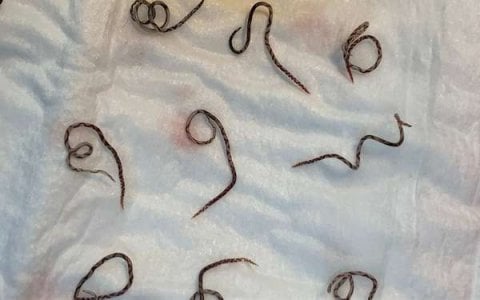This deadly brain worm is spreading—here’s where it’s headed next!
By
Maan
- Replies 4
Changing weather patterns and the movement of invasive species are quietly reshaping everyday life in Australia.
What might seem like a minor environmental shift could soon affect not only our health, but also what ends up on our dinner plates.
Experts are now sounding the alarm over a silent threat already making its way across the east coast.
Changing weather, an elusive parasite, and the risk of a backyard health threat—scientists have been tracking a troubling shift along Australia’s east coast, and the implications could reach further than many expect.
Originally from Southeast Asia, rat lungworm—Angiostrongylus cantonensis—had already established itself in parts of Queensland, but new research suggested the parasite had travelled as far south as Jervis Bay. Infections were no longer just rare cases found in wildlife, and experts warned the worm might not stop there.
Jan Šlapeta, senior author of a University of Sydney study, confirmed the unsettling possibility: ‘It has the potential to spread further. An indicator is that 20 or 30 years ago, we did not talk about it in America or Europe. Now it’s in the southern states of the United States, it’s creeping into Europe, it’s in Spain.’
The reason behind the parasite’s growing presence? Wetter, warmer conditions. According to the study, slugs and snails—prime carriers of the worm—flourished during heavy rain events, leading to spikes in infection. In fact, out of 93 reported cases in dogs across Sydney and Brisbane, 32 occurred shortly after a single downpour. Risk of infection remained high for up to 10 months after such weather events.
While it rarely caused illness in rats, slugs, or snails, the worm triggered dangerous immune reactions in other animals—and in humans. Most people never showed symptoms, but when they did, it could become life-threatening.
One of the more tragic cases dated back to 2010, when a Sydney man died after eating a slug on a dare.
Typically, people became infected by accidentally eating infected snails or slugs, or consuming raw vegetables contaminated by their slime trails. So far, larger garden snails had posed minimal risk because they were easy to spot—but that wasn’t guaranteed to last.
In Hawaii, a different invasive species had completely altered the game: Parmarion martensi, a tiny semi-slug so small it could cling undetected to fresh produce. That led to a dramatic surge in rat lungworm cases, with locals often ingesting the slugs unknowingly.
Australia had so far avoided the semi-slug, but Šlapeta issued a blunt warning: ‘If this semi-slug comes in, then it might end up on the veggies that people have got in their backyards. And that would change the landscape of this disease completely, like it changed in Hawaii.’
He added: ‘The parasite is invasive, the rat is invasive, the European slugs that we see in the backyards of Sydney are invasive, but if we bring in the semi-slug... it could change the way we grow greens and behave in restaurants.’
What made detection even more difficult was the subtle way rat lungworm crept into new areas. Sick animals in zoos often served as the first red flag, especially curious primates that had picked up slugs in their enclosures. Wildlife volunteers also played a role in spotting outbreaks, reporting unusual illness in creatures like possums and tawny frogmouths.
Since the parasite’s initial detection in Brisbane in the 1970s, at least six human infections had been documented—two of which were fatal. Yet experts believed many more cases likely went unnoticed or undiagnosed.
Šlapeta explained: ‘That’s the million dollar question. The parasite is moving wherever it wants. We can’t eliminate rats, we can’t eliminate slugs, so we just have to be more vigilant around the clinical signs in our pets and ourselves. But there’s not much we can do about tawny frogmouths. They will keep looking for some sort of food, and if the slug or snail is infected then they will become infected too.’
The key to managing the parasite’s spread, according to the University of Sydney researchers, lay in adopting a One Health approach—a strategy recognising the interconnected health of people, animals, and the environment. But even with this framework in place, Šlapeta admitted the path forward was murky.
Lead author Phoebe Rivory headed the study, which was published in the Journal of Infectious Diseases. The research underscored one pressing truth: as the climate grew more unpredictable, so too did the health risks hiding in our own backyards.
If you’ve never heard of rat lungworm before, you’re not alone—but the way it invades the body is truly unsettling.
For seniors who’ve spent years tending veggie gardens or picking fresh herbs, this one’s worth a closer look.
Watch the video to see how the parasite wreaks havoc—and why staying informed matters more than ever.
Source: Youtube/Discovery UK

With changing weather and new pests arriving on our doorstep, do you think we’ll need to rethink how we grow and prepare food at home? Let us know your thoughts in the comments.
In a previous story, we looked at a shocking case where surgeons made an almost unbelievable discovery inside a woman’s brain—a parasitic worm that left experts stunned.
For those concerned about unusual health risks, especially those linked to parasites, it’s a reminder that strange symptoms shouldn’t be ignored.
If that story slipped under your radar, it’s definitely worth a read.
Read more: Shocking discovery: What surgeons found inside this woman's brain is beyond unusual!
What might seem like a minor environmental shift could soon affect not only our health, but also what ends up on our dinner plates.
Experts are now sounding the alarm over a silent threat already making its way across the east coast.
Changing weather, an elusive parasite, and the risk of a backyard health threat—scientists have been tracking a troubling shift along Australia’s east coast, and the implications could reach further than many expect.
Originally from Southeast Asia, rat lungworm—Angiostrongylus cantonensis—had already established itself in parts of Queensland, but new research suggested the parasite had travelled as far south as Jervis Bay. Infections were no longer just rare cases found in wildlife, and experts warned the worm might not stop there.
Jan Šlapeta, senior author of a University of Sydney study, confirmed the unsettling possibility: ‘It has the potential to spread further. An indicator is that 20 or 30 years ago, we did not talk about it in America or Europe. Now it’s in the southern states of the United States, it’s creeping into Europe, it’s in Spain.’
The reason behind the parasite’s growing presence? Wetter, warmer conditions. According to the study, slugs and snails—prime carriers of the worm—flourished during heavy rain events, leading to spikes in infection. In fact, out of 93 reported cases in dogs across Sydney and Brisbane, 32 occurred shortly after a single downpour. Risk of infection remained high for up to 10 months after such weather events.
While it rarely caused illness in rats, slugs, or snails, the worm triggered dangerous immune reactions in other animals—and in humans. Most people never showed symptoms, but when they did, it could become life-threatening.
One of the more tragic cases dated back to 2010, when a Sydney man died after eating a slug on a dare.
Typically, people became infected by accidentally eating infected snails or slugs, or consuming raw vegetables contaminated by their slime trails. So far, larger garden snails had posed minimal risk because they were easy to spot—but that wasn’t guaranteed to last.
In Hawaii, a different invasive species had completely altered the game: Parmarion martensi, a tiny semi-slug so small it could cling undetected to fresh produce. That led to a dramatic surge in rat lungworm cases, with locals often ingesting the slugs unknowingly.
Australia had so far avoided the semi-slug, but Šlapeta issued a blunt warning: ‘If this semi-slug comes in, then it might end up on the veggies that people have got in their backyards. And that would change the landscape of this disease completely, like it changed in Hawaii.’
He added: ‘The parasite is invasive, the rat is invasive, the European slugs that we see in the backyards of Sydney are invasive, but if we bring in the semi-slug... it could change the way we grow greens and behave in restaurants.’
What made detection even more difficult was the subtle way rat lungworm crept into new areas. Sick animals in zoos often served as the first red flag, especially curious primates that had picked up slugs in their enclosures. Wildlife volunteers also played a role in spotting outbreaks, reporting unusual illness in creatures like possums and tawny frogmouths.
Since the parasite’s initial detection in Brisbane in the 1970s, at least six human infections had been documented—two of which were fatal. Yet experts believed many more cases likely went unnoticed or undiagnosed.
Šlapeta explained: ‘That’s the million dollar question. The parasite is moving wherever it wants. We can’t eliminate rats, we can’t eliminate slugs, so we just have to be more vigilant around the clinical signs in our pets and ourselves. But there’s not much we can do about tawny frogmouths. They will keep looking for some sort of food, and if the slug or snail is infected then they will become infected too.’
The key to managing the parasite’s spread, according to the University of Sydney researchers, lay in adopting a One Health approach—a strategy recognising the interconnected health of people, animals, and the environment. But even with this framework in place, Šlapeta admitted the path forward was murky.
Lead author Phoebe Rivory headed the study, which was published in the Journal of Infectious Diseases. The research underscored one pressing truth: as the climate grew more unpredictable, so too did the health risks hiding in our own backyards.
If you’ve never heard of rat lungworm before, you’re not alone—but the way it invades the body is truly unsettling.
For seniors who’ve spent years tending veggie gardens or picking fresh herbs, this one’s worth a closer look.
Watch the video to see how the parasite wreaks havoc—and why staying informed matters more than ever.
Source: Youtube/Discovery UK
Key Takeaways
- Rat lungworm, originally from Southeast Asia, has spread as far south as Jervis Bay due to warmer, wetter weather.
- The parasite infects via slugs and snails, posing severe risks to humans and animals—especially after heavy rain.
- Australia may face a major health shift if the invasive semi-slug, already a problem in Hawaii, arrives undetected.
- Researchers warn that vigilance and a One Health approach are needed, but controlling the parasite’s spread remains difficult.
With changing weather and new pests arriving on our doorstep, do you think we’ll need to rethink how we grow and prepare food at home? Let us know your thoughts in the comments.
In a previous story, we looked at a shocking case where surgeons made an almost unbelievable discovery inside a woman’s brain—a parasitic worm that left experts stunned.
For those concerned about unusual health risks, especially those linked to parasites, it’s a reminder that strange symptoms shouldn’t be ignored.
If that story slipped under your radar, it’s definitely worth a read.
Read more: Shocking discovery: What surgeons found inside this woman's brain is beyond unusual!








